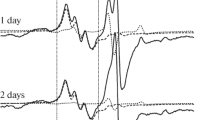Abstract
It has been shown that after 5 h of spinal cord injury, there is a decrease of nitric oxide (NO) production in the spinal cord. Seventy-two hours after the spinal cord injury, the level of NO production in the spinal cord and the heart increases by 2.5 times, and in the liver, it increases threefold. In the chronic period of a traumatic spinal cord disease in the spinal cord tissue, the level of NO production was significantly higher than at the control level.

Similar content being viewed by others
References
Ignarro, L. J., Buga, G. M., Wood, K. S., Byrns, R. E., Chaudhuri, G. (1987). Endothelium-derived relaxing factor produced and released from artery and vein is nitric oxide. Proceedings of the National Academy of Sciences of the United States of America, 84, 9265–9269.
Vanin, A. F. (1998). Dinitrosyl iron complexes and S-nitrosothiol—two possible forms of stabilization and transport of nitric oxide in biological systems. Biohimia (in Russian), 63, 924–938.
Boehning, D., & Snyder, S. H. (2003). Novel neural modulators. Annual Review of Neuroscience, 26, 105–131.
Sitdikova, G. F., & Zefirov, A. L. (2006). Gaseous messengers in nerve system Rossiiskii fizioilogicheskii zurnal imeni I.M. Sechenova, 92, 872–882.
Zamora, R., Vodovotz, V., Billiar, T. R. (2000). Inducible nitric oxide synthase and inflammatory diseases. Molecular Medicine, 6, 347–373.
Bredt, D. S. (2003). Nitric oxide signaling in brain: potentiating the gain with YC-1. Molecular Pharmacology, 63, 1206–1208.
Tomomi, G., & Masataka, M. (2006). Nitric oxide and endoplasmic reticulum stress arteriosclerosis. Thrombosis and Vascular Biology, 26, 1439–1446.
Sharma, H. S., Badgaiyan, R. D., Alm, P., Mohanty, S., Wiklund, L. (2005). Neuroprotective effects of nitric oxide synthase inhibitors in spinal cord injury-induced pathophysiology and motor functions: an experimental study in the rat. Annals of the New York Academy of Sciences, 1053, 422–434. doi:10.1196/annals.1344.037.
Kwak, E. K. (2005). The role of inducible nitric oxide synthase following spinal cord injury in rat. Journal of Korean Medical Science, 20, 663–669.
Conti, A., Miscusi, M., Cardali, S., Germano, A., Suzuki, H., Cuzzocrea, S., et al. (2007). Nitric oxide in the injured spinal cord: synthases cross-talk, oxidative stress and in ammation. Brain Research Reviews, 54, 205–218. doi:10.1016/j.brainresrev.2007.01.013.
Marsala, J., Orendácová, J., Lukácová, N., Vanický, I. (2007). Traumatic injury of the spinal cord and nitric oxide. Progress in Brain Research, 161, 171–183.
Yafarova, G. G., Tumakaev, R. F., Khazieva, A. R., Baltina, T. V. (2014). Influence of local hypothermia on H- and M- responses after contusia spinal cord injury in dogs. Biofizika, 59, 1017–1022.
Mikoyan, V. D., Kubrina, L. N., Serezhenkov, V. A., Stukan, R. A., Vanin, A. F. (1997). Complexes of Fe2+ with diethyldithiocarbamate or N-methyl-D-glucamine dithiocarbamate as traps of nitric oxide in animal tissues. Biochimica Biophysica Acta, 1336, 225–234.
Gainutdinov, K. L., Andrianov, V. V., Iyudin, V. S., Yurtaeva, S. V., Jafarova, G. G., Faisullina, R. I., et al. (2013). EPR study of nitric oxide production in rat tissues under hypokinesia. Biophysics, 58, 203–205. doi:10.1134/s0006350913020073.
Gainutdinov, K. L., Gavrilova, S. A., Iyudin, V. S., Golubeva, A. V., Davydova, M. P., Jafarova, G. G., et al. (2011). EPR study of the intensity of the nitric oxide production in rat brain after ischemic stroke. Applied Magnetic Resonance, 40, 267–278. doi:10.1007/s00723-011-0207-7.
Hamada, Y., Ikata, T., Katoh, S., Tsuchiya, K., Niwa, M., Tsutsumishita, Y., et al. (1996). Roles of nitric oxide in compression injury of rat spinal cord. Free Radical Biology & Medicine, 20, 1–9.
Acknowledgments
This work was funded by the subsidy of the Russian Government to support the Program of Competitive Growth of Kazan Federal University among the World’s Leading Academic Centers (agreement No.02.A03.21.0002).
Author information
Authors and Affiliations
Corresponding author
Rights and permissions
About this article
Cite this article
Yafarova, G.G., Andrianov, V.V., Yagudin, R.K. et al. Nitric Oxide Production in the Rat Spinal Cord, Heart, and Liver After Spinal Cord Injury. BioNanoSci. 6, 332–334 (2016). https://doi.org/10.1007/s12668-016-0229-6
Published:
Issue Date:
DOI: https://doi.org/10.1007/s12668-016-0229-6




